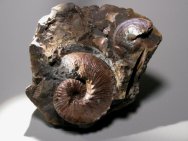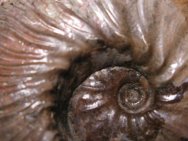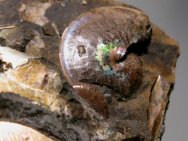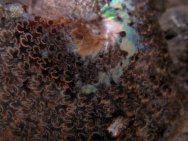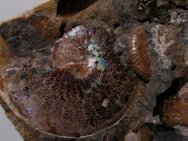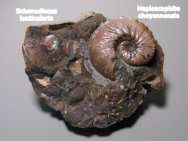 Description:
During the Upper Cretaceous, a huge shallow inland sea stretched
from what currently is the Gulf of Mexico northward and through
Canada. Ammonites including members of Ammonita Superfamily Scaphitaceae
(the scaphites) were ubuiquitous. The Fox Hills Formation, which
spans from Alberta down into Colorado, was formed when
the Western
Interior Seaway retreated in the late Cretacous.
It Description:
During the Upper Cretaceous, a huge shallow inland sea stretched
from what currently is the Gulf of Mexico northward and through
Canada. Ammonites including members of Ammonita Superfamily Scaphitaceae
(the scaphites) were ubuiquitous. The Fox Hills Formation, which
spans from Alberta down into Colorado, was formed when
the Western
Interior Seaway retreated in the late Cretacous.
It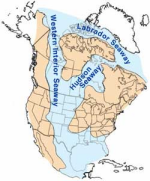 contains
a diverse biota, including Tyrannosauroid dinosaurs like T-Rex
and marine mosasaurs. The formation is also well known for several
species of scaphites having their exterior shells preserved as
mother of pearl, an opal-like and iridescent mineral sometimes
called ammolite; the color you see often changes as the angle
of viewing or of light source changes, because of multiple reflections
within layers of the material. Fox
Hill scaphites and ammonites typically exhibit red and/or green hues,
and browns, a mixture of red and green. Others are whitish, a
nearly
uniform
mixture of the color spectrum. contains
a diverse biota, including Tyrannosauroid dinosaurs like T-Rex
and marine mosasaurs. The formation is also well known for several
species of scaphites having their exterior shells preserved as
mother of pearl, an opal-like and iridescent mineral sometimes
called ammolite; the color you see often changes as the angle
of viewing or of light source changes, because of multiple reflections
within layers of the material. Fox
Hill scaphites and ammonites typically exhibit red and/or green hues,
and browns, a mixture of red and green. Others are whitish, a
nearly
uniform
mixture of the color spectrum.
The
primary diagnostic feature of scaphites is somewhat J-shaped,
bauplan, one that is less tightly coiled than most ammonites.
They are grouped
among the heteromorph ammonites comprising suborder Ancyloceratina,
because
of these
irregularly-coiled shells. The scaphites of Fox Hills Formation
are normally found in concretions, like 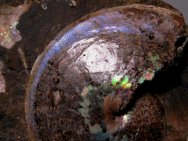 fossils of Mazon Creek,
some very large, that weather out from stream beds
and hillsides. And like Mazon Creek, exquisite preservation is
often found. Some of the different scaphite species exhibit shell
ornamentation, including tubercles, sutures, keels, and ribs. fossils of Mazon Creek,
some very large, that weather out from stream beds
and hillsides. And like Mazon Creek, exquisite preservation is
often found. Some of the different scaphite species exhibit shell
ornamentation, including tubercles, sutures, keels, and ribs.
This
is a scaphite and ammonite association rarely found at the Fox
Hills Formation. The larger is Hoploscaphites cheyennensis scaphite
retains most
of its shell. The Spenodiscus lenticularis is stunning, in places
showing the intricate suture pattern the genus is noted for.
Also, depending on angle of view, the Spenodiscus exhibits a
rainbow of colors, including a bluish-lavender I've seldom seen
- the
many pictures are a futile attempt to capture those colors. Also
note a third small ammonoid half embedded and perpendicular to
the matrix.
|

 contains
a diverse biota, including Tyrannosauroid dinosaurs like T-Rex
and marine mosasaurs. The formation is also well known for several
species of scaphites having their exterior shells preserved as
mother of pearl, an opal-like and iridescent mineral sometimes
called ammolite; the color you see often changes as the angle
of viewing or of light source changes, because of multiple reflections
within layers of the material. Fox
Hill scaphites and ammonites typically exhibit red and/or green hues,
and browns, a mixture of red and green. Others are whitish, a
nearly
uniform
mixture of the color spectrum.
contains
a diverse biota, including Tyrannosauroid dinosaurs like T-Rex
and marine mosasaurs. The formation is also well known for several
species of scaphites having their exterior shells preserved as
mother of pearl, an opal-like and iridescent mineral sometimes
called ammolite; the color you see often changes as the angle
of viewing or of light source changes, because of multiple reflections
within layers of the material. Fox
Hill scaphites and ammonites typically exhibit red and/or green hues,
and browns, a mixture of red and green. Others are whitish, a
nearly
uniform
mixture of the color spectrum.

